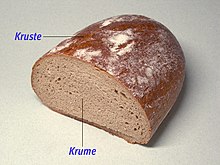Bread crust
As a crust of bread or bread crust , the outer hard shell of is bread called. It protects the moist and soft crumb from biological pests and mechanical damage, improves the shelf life and significantly affects the taste of the bread. With different shapes, baking processes and surface treatments, a large number of breads with different characters and different crispness can be produced from one base dough.
The Maillard reaction and the formation of light and dark dextrins are of decisive importance in crust formation . These reactions not only create the brown colorings, but also flavor and odor substances that shape the aroma . With sourdough bread , these processes are favored, since preliminary stages for these processes arise during sourdough maturation. Substances that are toxicologically unsafe for humans are also formed. One of these substances is acrylamide , which is increasingly formed at a baking temperature of over 180 ° C. However, melanoidins are also formed , which can have an antioxidant and anti-cancer effect. When using bread makers , there is no noticeable crust because the dough is not surrounded by hot and humid air.
When it cools down, some of the aromas pass into the crumb and contribute to its taste. This is particularly important with pure white bread and rolls.
Bakeries use gelatinized potato starch to seal smooth crusts after baking. This seals the crust well and gives it an intense shine. It is common practice to lightly toast the potato starch before adding boiling water to gelatinize it to increase the concentration of light and dark dextrins.
The cracks in the bread crust caused by cutting or plaiting are known as parapets .
Rose
A quality feature of the bread crust is the crispy. A crispy bread crust is crispy and ideally delicate. The rose is seen as a sign of freshness. After baking, the bread crust usually only has a water content of 5–10%, while the crumb is more moist. Due to the moisture balance, the crust loses its crispness over time.
Individual evidence
- ^ IREKS Arkady Institute for Bakery Science (ed.): IREKS ABC of the bakery. 4th edition. Institute for Bakery Science, Kulmbach 1985.
- ↑ Belitz, Grosch, Schieberle: Textbook of Food Chemistry , Springer, 2007, ISBN 3540732012 .
- ^ Handbook sourdough , editor: Gottfried Spicher, M. Brandt, Biologie, Biochemie, Technologie, 6th edition, 2006, Behr's Verlag, ISBN 3899471660 .
- ^ Josef Loderbauer: The baker's book in learning fields . 4th edition. Handwerk und Technik, Hamburg 2008, ISBN 978-3-582-40205-9 , p. 140 .
- ↑ Online encyclopedia for baking bread - Rösche , baeckerlatein.de, accessed on March 8, 2018
- ^ Claus Schünemann: Learning fields of the bakery and confectionery - sales . 3rd edition, Gilde-Verlagsservice 2011. ISBN 978-3773401700 . P. 318. Online view


